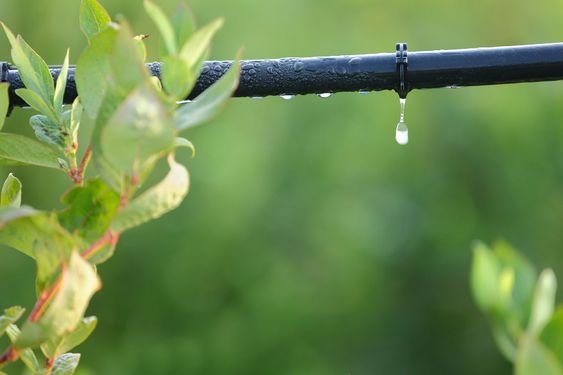

Globally, water resources are becoming increasingly scarce. Against this backdrop, drip irrigation tape, as an efficient water-saving irrigation device, is becoming an indispensable tool in modern agriculture. Its unique design and functions not only significantly improve the efficiency of water use but also provide precise water and nutrient support for crop growth. The application of drip irrigation tape is injecting new vitality into the sustainable development of global agriculture.
Water-saving and Increased Efficiency: Drip irrigation tape delivers water directly to the roots of crops, reducing evaporation and runoff. The water utilization rate can reach 95%. Compared with traditional irrigation methods, drip irrigation tape can save 50%-70% of water. For example, in Israel, the application of drip irrigation technology has enabled the country to achieve high agricultural output and efficiency despite extreme water scarcity. At the same time, drip irrigation tape can also increase crop yield by 10%-30%, bringing higher economic benefits to farmers.
Precision Fertilization: Drip irrigation tape can be combined with fertilization systems to deliver soluble fertilizers to the root zone of crops, achieving integrated water and fertilizer management. This method increases fertilizer utilization by 30%-50%. This precise fertilization not only reduces fertilizer waste but also promotes the healthy growth of crops. In India, many farmers have significantly increased the yield and quality of crops by using drip irrigation tape in combination with fertilization systems.
Improved Soil Structure: The micro-irrigation method of drip irrigation tape protects soil structure, avoiding soil erosion and compaction caused by traditional irrigation methods, thereby maintaining soil aeration and fertility. In Australia, on some farms, the use of drip irrigation tape has significantly improved soil aeration and fertility, resulting in more developed crop root systems.
Reduced Pest and Disease: The localized micro-irrigation method of drip irrigation tape keeps most of the soil surface dry, reducing the incidence of pests and diseases, and in turn reducing the use of pesticides. In Brazil, in some orchards, the incidence of pests and diseases has been reduced by 30%-40% after using drip irrigation tape, and the use of pesticides has been reduced by 20%-30%.
Strong Adaptability: Drip irrigation tape is suitable for a variety of crops and different types of farmland, including fruit trees, vegetables, cash crops, and greenhouse irrigation. It is also easy to install and operate, making it suitable for farmland of various terrains and sizes. In Africa, on some small-scale farms, the ease of use of drip irrigation tape makes it an ideal irrigation choice.
Global Demand Growth: With increasing global attention to water scarcity and the popularization of precision agriculture technology, the drip irrigation tape market is showing a rapid growth trend. In 2023, the global drip irrigation tape market size was 1.91 billion USD, and it is expected to grow at a compound annual growth rate of 6.24% from 2024 to 2032. This growth trend not only reflects the advantages of drip irrigation tape in water-saving and increased production but also indicates the urgent need of global agriculture for efficient irrigation technology.
Opportunities for Developing Economies: In developing economies, the adoption rate of drip irrigation tape is increasing. These regions face challenges such as water scarcity and weak infrastructure, and the low maintenance cost and high water-saving performance of drip irrigation tape make it an ideal irrigation solution. For example, in India and China, governments encourage farmers to use drip irrigation tape through subsidies and promotion projects to improve agricultural production efficiency and water use efficiency.
Technological Innovation Drives Development: In the future, with the introduction of the Internet of Things and data analysis technology, drip irrigation tape is expected to achieve smarter irrigation management, further improving the efficiency of water use. For example, by installing sensors and automated control systems, farmers can monitor soil moisture and crop needs in real time to achieve precise irrigation, further enhancing the water-saving and increased production effects of drip irrigation tape.
Greenhouse: In greenhouses, drip irrigation tape can effectively reduce the incidence of pests and diseases, save fertilizers and pesticides, and increase economic benefits. For example, in the Netherlands, in greenhouse vegetable cultivation, the application of drip irrigation tape has increased vegetable yield by 20%-30%, while reducing the use of fertilizers and pesticides by 30%-40%.
Orchard Irrigation: Drip irrigation tape can effectively increase the yield of orchards, improve fruit quality, and control weed growth. In Spain, in some citrus orchards, the use of drip irrigation tape has increased citrus yield by 15%-20% and significantly improved fruit quality.
Field Crops: Drip irrigation tape is suitable for a variety of field crops, such as cotton, medicinal plants, watermelons, and field vegetables, and can increase the level of mechanized planting. In Brazil, in some cotton planting areas, the application of drip irrigation tape has increased cotton yield by 25%-30%, while reducing irrigation water by 20%-25%.
Saline-Alkali Land Reclamation: Drip irrigation tape can maintain a high level of moisture in the crop root zone, reducing the sensitivity of crops to salinity, and effectively preventing the harm of saline-alkali land to crops. In some saline-alkali land planting areas in the Middle East, the application of drip irrigation tape has increased the survival rate of crops by 30%-40% and increased yield by 20%-25%.
Drip irrigation tape, with its significant water-saving effects, precise fertilization capabilities, wide adaptability, and good soil protection properties, is becoming an indispensable irrigation tool in modern agriculture. Against the backdrop of global water scarcity, the promotion and application of drip irrigation tape not only help to improve agricultural production efficiency but also promote the sustainable development of agriculture. With continuous technological innovation and market expansion, drip irrigation tape will play a more important role in future agricultural production. In the future, we look forward to the wider application of drip irrigation tape technology around the world, making a greater contribution to the sustainable development of global agriculture.